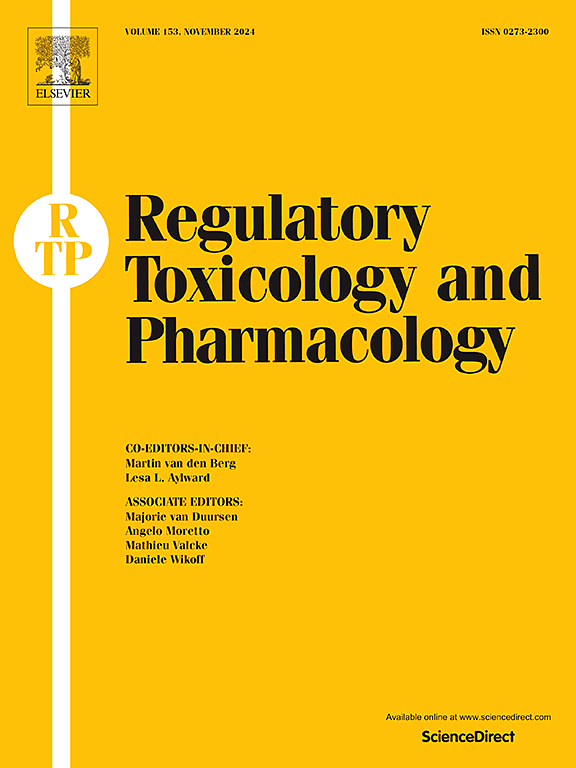溴仿是海藻天冬酰胺属的一种天然成分,用于抑制牛体内的甲烷生成,其毒理学表明对人类的风险可以忽略不计。
IF 3.5
4区 医学
Q1 MEDICINE, LEGAL
引用次数: 0
摘要
红海藻、天冬酰胺和阿玛塔藻抑制反刍动物甲烷的产生,被认为是由溴仿介导的。本文综述了溴仿的毒理学、代谢、流行病学和药理学。国际癌症研究机构得出结论,溴仿不能归类为对人类的致癌物,而美国环境保护局根据长期高剂量灌胃的雌性大鼠肠道肿瘤的低发病率将其归类为可能的人类致癌物。在相同的条件下,小鼠没有表现出肿瘤,这表明肿瘤的形成是继发于局部细胞毒性。虽然有一些体外证据表明溴仿具有致突变的潜力,可能是通过涉及GSTT-1的代谢途径,但在低剂量下,这一途径不太可能相关。来自饮用水消毒副产物研究的人类证据尚无定论。虽然一些残留研究发现牛奶中有溴仿,但浓度接近背景水平,不会造成显著的癌症风险。这些发现的共同含义是,溴仿作为一种环境抑制剂,不会造成重大风险。预防措施将确保溴仿的摄入量不超过瘤胃的降解能力,从而使组织和牛奶中的残留浓度以及由此产生的饮食接触量降到最低,并低于相关的基于健康的指导值。本文章由计算机程序翻译,如有差异,请以英文原文为准。
Toxicology of bromoform, a natural constituent of the seaweed Asparagopsis spp. used to inhibit methanogenesis in cattle, suggests negligible risks to humans
The red seaweeds, Asparagopsis taxiformis and A. armata inhibit methane production in ruminants, considered to be mediated by bromoform. This review examines the toxicology, metabolism, epidemiology and pharmacology of bromoform. IARC concludes bromoform is not classifiable as a carcinogen to humans, whereas the US EPA classifies it as a probable human carcinogen based on a low incidence of intestinal tumours in female rats given high gavage doses chronically. Under the same conditions, mice exhibited no tumours, suggesting that tumour formation is secondary to localised cytotoxicity. While there is some in vitro evidence of mutagenic potential for bromoform, likely via a metabolic pathway involving GSTT11-1, this pathway is unlikely to be relevant at low doses. The human evidence, from drinking water disinfection by-product studies, is inconclusive. While some residue studies find bromoform in milk, the concentrations approach background levels and pose no significant cancer risk. The collective implication of these findings is that bromoform, as an environmental inhibitor, does not pose a significant risk. A precautionary approach would ensure that bromoform intake does not exceed the capacity for rumen degradation such that concentrations of residues in tissues and milk and consequent dietary exposure are minimised and below relevant health-based guidance values.
求助全文
通过发布文献求助,成功后即可免费获取论文全文。
去求助
来源期刊
CiteScore
6.70
自引率
8.80%
发文量
147
审稿时长
58 days
期刊介绍:
Regulatory Toxicology and Pharmacology publishes peer reviewed articles that involve the generation, evaluation, and interpretation of experimental animal and human data that are of direct importance and relevance for regulatory authorities with respect to toxicological and pharmacological regulations in society. All peer-reviewed articles that are published should be devoted to improve the protection of human health and environment. Reviews and discussions are welcomed that address legal and/or regulatory decisions with respect to risk assessment and management of toxicological and pharmacological compounds on a scientific basis. It addresses an international readership of scientists, risk assessors and managers, and other professionals active in the field of human and environmental health.
Types of peer-reviewed articles published:
-Original research articles of relevance for regulatory aspects covering aspects including, but not limited to:
1.Factors influencing human sensitivity
2.Exposure science related to risk assessment
3.Alternative toxicological test methods
4.Frameworks for evaluation and integration of data in regulatory evaluations
5.Harmonization across regulatory agencies
6.Read-across methods and evaluations
-Contemporary Reviews on policy related Research issues
-Letters to the Editor
-Guest Editorials (by Invitation)

 求助内容:
求助内容: 应助结果提醒方式:
应助结果提醒方式:


